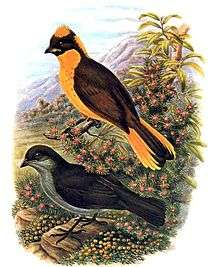Golden bowerbird
The golden bowerbird (Prionodura newtoniana) is a species of bird in the family Ptilonorhynchidae, the bowerbird. It is endemic to Queensland in Australia, where it is limited to the Atherton region.[1]
| Golden bowerbird | |
|---|---|
 | |
| Scientific classification | |
| Kingdom: | Animalia |
| Phylum: | Chordata |
| Class: | Aves |
| Order: | Passeriformes |
| Family: | Ptilonorhynchidae |
| Genus: | Prionodura De Vis, 1883 |
| Species: | P. newtoniana |
| Binomial name | |
| Prionodura newtoniana De Vis, 1883 | |
Distribution
This species has a patchy distribution in northeastern Queensland. Though it has a limited range, it is common in the area, and populations are apparently stable. It is a least-concern species on the IUCN Red List.[1] This bird lives in rainforests above 700 meters in elevation, including some habitat that has been disturbed by human activities such as logging.[1]
Description
The male golden bowerbird has a brown head and brown wings which are bright yellow-gold underneath, as are the tail, crest and nape. The female is olive brown with ash-gray underparts. Immatures look similar to the female except their eyes are brown.[2]
This is the smallest species of bowerbird.[3]
Life history
The golden bowerbird feeds mainly on fruits, and sometimes takes insects and spiders.[4]
Like most other bowerbirds, the male builds and maintains a bower over several years. Males do not grow their adult plumage for at least five or six years, during which time they wander, learn the social hierarchy of mature males, and practice building bower-like structures. Upon maturity, a male establishes his bower site, builds his structure, and spends much time decorating it. He may steal decorations from his neighbours, and defend his possessions from other males. During the breeding season, generally August through December, the male perches at his bower and produces a number of vocalizations, which attract females.[4]
The female establishes a nest in cup-shaped crevices, usually in tree trunks. There are one to two eggs per clutch. The nestlings are fed fruit and insects, and fledging occurs most often in January.[5]
Gallery
References
- BirdLife International. 2016. Prionodura newtoniana. The IUCN Red List of Threatened Species 2016. Downloaded on 22 June 2017.
- Morcombe, M. The field guide to Australian birds. Steve Parish Publishing. 2004.
- Animals and plants that could be lost because of climate change – in pictures. The Guardian 30 April 2015.
- Frith, C. B. and D. W. Frith. (2000). Home range and associated sociobiology and ecology of male Golden Bowerbirds Prionodura newtoniana (Ptilonorhynchidae). Memoirs of The Queensland Museum' 45:343-357.
- Frith, C. B. and D. W. Frith. (1998). Nesting biology of the golden bowerbird Prionodura newtoniana endemic to Australian upland tropical rainforest. Emu 98 245-68.



